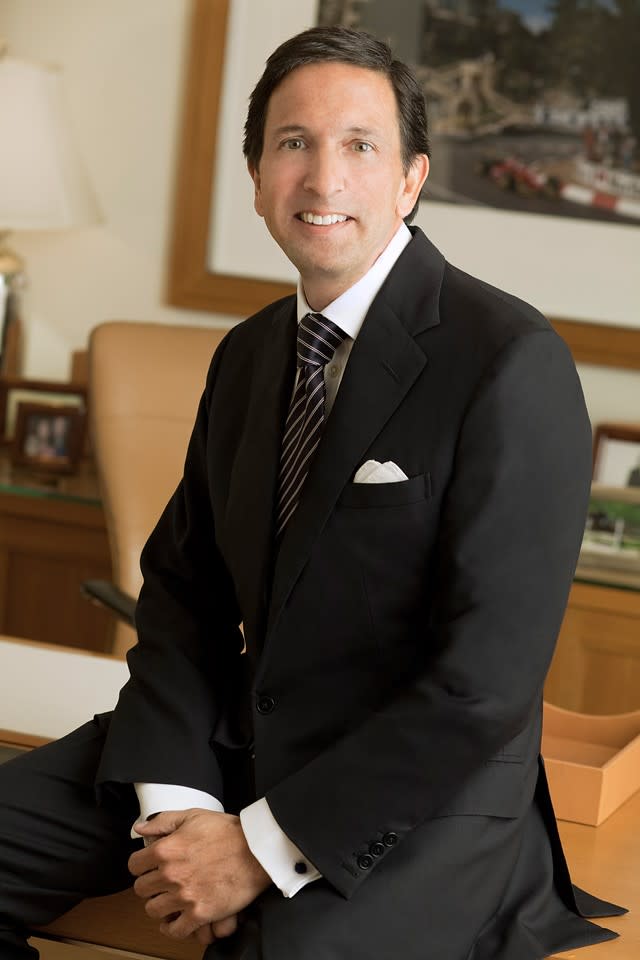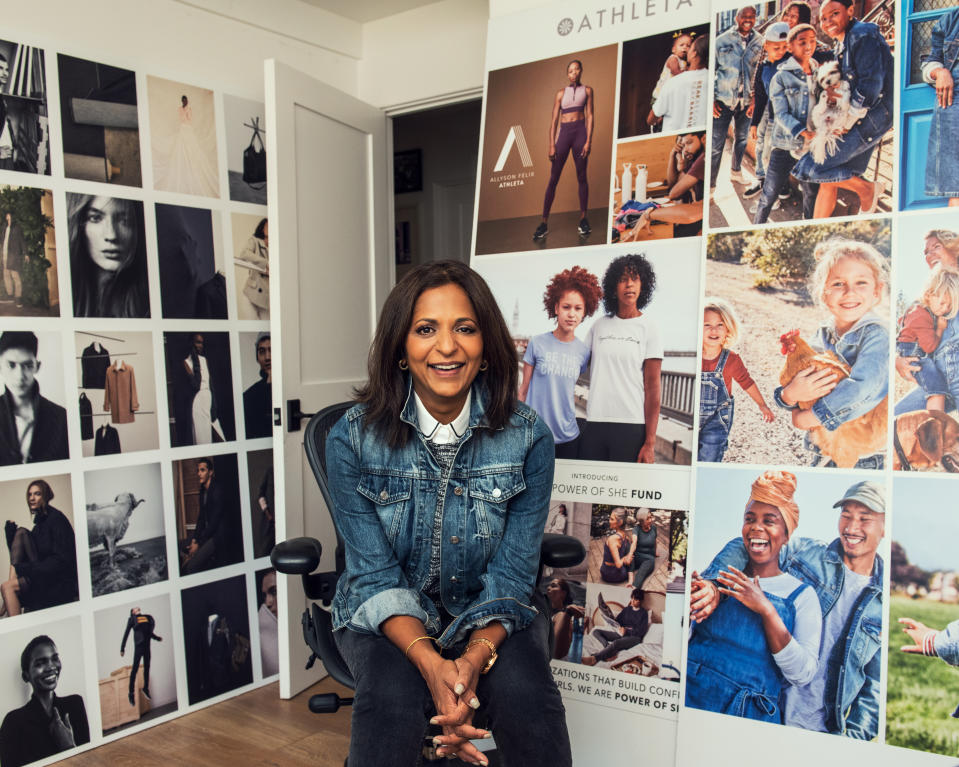CEOs at Walmart, Macy’s, Gap, Nordstrom and Capri Look to the Future

While the models hit the catwalk for New York Fashion Week, the fashion and retail chiefs were focused on the investment set downtown on Wall Street.
A parade of big-time chief executive officers spoke at Goldman Sachs’ annual retail conference Thursday, pitching their vision of the post-pandemic future, teasing potential acquisitions and touting their newfound digital expertise.
More from WWD
The specifics of the last 18 months or so at Macy’s Inc., Walmart Inc., Nordstrom Inc., Capri Holdings and Gap Inc. might all be different, but much of the narrative is the same — consumer companies have managed to navigate the pandemic surprisingly well and have used the disruption to retool.
While the Delta variant and supply chain disruptions continue to be vexing, the industry’s top executives are looking beyond the coronavirus with plans to win big in the new world. Here, a look ahead to the holidays, the post-pandemic playbook and beyond.
Macy’s
Macy’s Inc. is attracting new customers, building confidence on Wall Street, and remains bullish on healthy gains for the rest of this year.
But while successfully transcending supply chain and COVID-19 headwinds this year, in 2022 there could be new headwinds swirling around including inflation, rising delivery expenses, price promoting and challenges “lapping” the robust sales gains this year stemming from consumers getting back out again to socialize and shop after being cooped up by COVID-19.
“We have been able to successfully reengage our core customer through the pandemic and the headline for us is being able to attract new customers,” said Jeff Gennette, Macy’s Inc. chairman and CEO.
Last quarter, “We beat expectations for the third consecutive quarter,” Gennette said. The retailer reported net income of $345 million for the quarter ended July 31 as sales rose to $5.65 billion versus $3.56 billion a year earlier.
“So we have momentum,” Gennette said, adding Macy’s is being driven by data-centric loyalty and personalization efforts, pricing science, inventory management and agility in adjusting its wide luxury to off-price offering. He also cited Macy’s newfound inclination to add categories previously not carried — home fitness, pets, outdoor recreation — as well as expanding in toys through the new partnership with Toys ‘R’ Us.
“Consumers have money to spend and we’re just confident that spending will continue, even with all the [coronavirus] restrictions that might be coming with the new variants, changes in back-to-work, or with what’s going on with the supply chain. And all through this, we’ve seized every opportunity to capitalize on the breadth of our offering with all of these changing consumer demand patterns, and just super proud of our team and how they’ve responded. That level of response, that level of agility is just going to be critical to us sustaining momentum whatever comes our way going into 2022,” the CEO said.

Mark Lennihan/Courtesy Photo
Walmart
Shoppers continue to spend money at a healthy pace, despite the uncertainties caused by the pandemic.
“The consumer is doing pretty good and they’re spending money and we don’t see an abrupt stop to that,” said CEO Doug McMillon. “You’ve got a continuum, of course, of income levels and wealth levels in the U.S. and there are going to be a lot of people with plenty of spending capacity. For customers at the lower end of that scale, wage rates are going up. So as we look ahead to next year and in the U.S. in particular, and to some extent other markets, I think that’s one of the things, in addition to some of the things that are happening with various forms of government assistance, that will cause us to have a consumer [who] is strong for some time.”
McMillon added that consumers, after more than a year of lockdowns and forced quarantine, will be eager to celebrate the upcoming holidays among friends, with all the trimmings.
Meanwhile, supply chain issues continue to plague the entire retail space and McMillon said Walmart has fared no better, with container shortages, lack of labor and higher prices throughout the system.
“So there are a lot of things to overcome and it requires creativity and flexibility,” the seasoned retail executive said, adding that changing sources at various points along the supply chain is the number-one way to mitigate pressures.
Still, he said there’s plenty of room for the mass-channel retailer, which logged $4.2 billion in consolidated net income in the last three months, to grow, especially in the home, food and apparel categories, both online and in stores.
“I see so much opportunity for us on the e-commerce side to add skus and add brands to improve our execution,” McMillon said. “And while we’ve had tremendous growth in the last couple of years there’s just a lot more upside in front of us in apparel.”

John Idol
Capri
John Idol, chairman and CEO of Capri Holdings, isn’t done empire building even though he is preparing to hand the reins of the company next year to Joshua Schulman, who was recently named CEO of Michael Kors and heir apparent.
Idol took Michael Kors public in 2011 and moved to build the next luxury group, scooping up Versace and Jimmy Choo — and the CEO was crowing at the conference that those brands all still have growth ahead.
“Luxury brands are obviously built around quality, heritage, history, storytelling and also around fashion. Luxury today is fashion, and it’s fun, but people want to invest in things that will stand the test of time,” Idol said. “And I think we have companies now that are really standing the test of time.”
And Idol is keeping his eyes peeled.
“There was a lot of fear in the marketplace about our ability to acquire companies, execute on those acquisitions and pay down debt. And I think given the growth of Versace, now the renewed growth of Jimmy Choo, I think, we’ve proven that we can do that,” he said.
The company plans to spend some time paying down more debt first, but Idol said it would have “very, very little debt” at the end of next year.
“So we’ll be in a very strong position to be in the market for at least one additional acquisition,” he said. “And our goal is to hopefully do that over the next two years or so if a quality asset becomes available.”

Patrick MacLeod/Footwear News
Nordstrom
Nordstrom is known for its obsession with customer service — and is finding now that keeping up with shoppers today requires some new tricks.
“We’ve always put the customer first,” said CEO Erik Nordstrom. “But over the last two years, we have seen a transformation…what the customer wants and where and how the customer shops.”
It’s a change Nordstrom has been preparing for, in part by looking to serve markets with a cluster of stores that each serve their own function and reinforce each other, from the mainline stores to the Rack off-price store and the Nordstrom Local service concept.

Gap
Sonia Syngal stepped into the corner office as president and CEO of Gap in March 2020 — just as the world fell apart.
She’s used that tough start to look at the business with new eyes and broaden the possibilities at the company, which owns Old Navy, Gap, Banana Republic and Athleta.
Under her leadership Gap launched into home with Walmart and teamed with Kanye West, Old Navy is expanding in the plus-size area and more.
“As we think about the future, there’s so much ahead,” Syngal said. “We are doubling down on investing in these brands and investing in our simple strategy of growing these purpose-driven lifestyle brands. And we’re seeing that. These four brands have a lot of reach. They’ve been around for a long time. And they have a very high brand health and awareness, which gives us an ability to grow them, both in the categories that we are active in today, which is apparel and accessories.
“But also, as we think about consumer trends over the long term, the trends being home centricity and the home body culture that COVID-19 fueled, as well as wellness in our brands, we believe that permission to explore expansion across multiple categories and therefore, more addressable spend,” she said. “So lots ahead over the next horizon, and specifically for the 12 months, the investments we’re making in marketing and in technology, we think will allow the acceleration that we expect.”
In addition to some new thinking, Syngal brings some real scale to the effort and noted that the company has a $4 billion kids business, a $3 billion denim business and a $4 billion active business.
Sign up for WWD's Newsletter. For the latest news, follow us on Twitter, Facebook, and Instagram.

